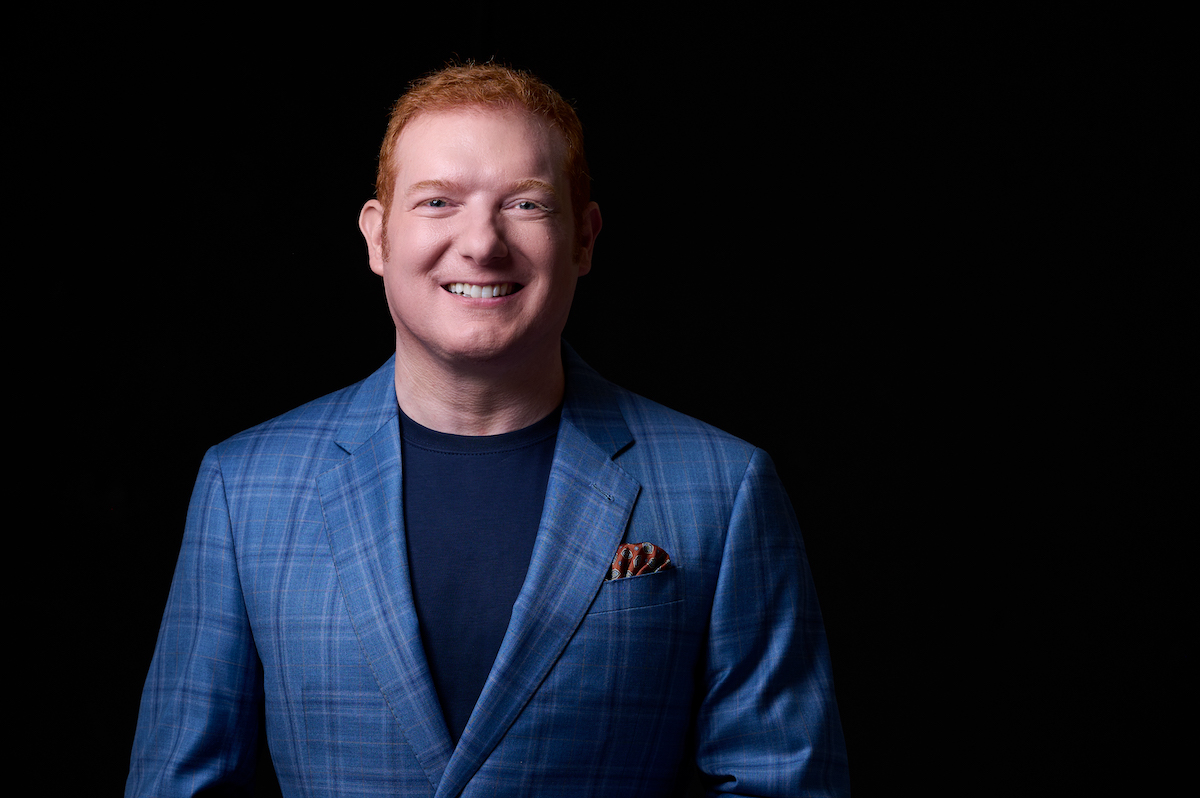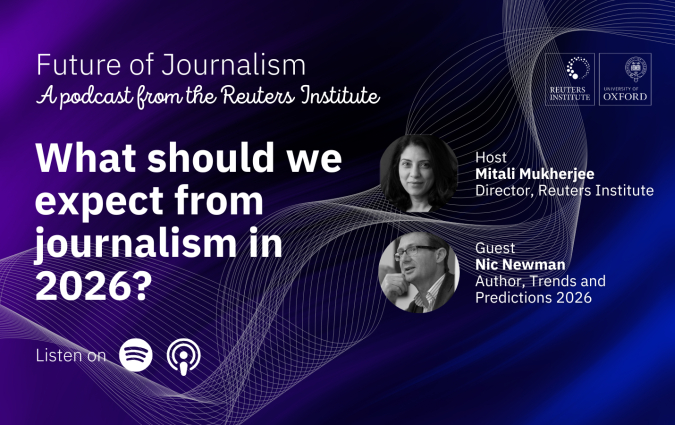Is it possible to build a local radio station powered by AI? This tech CEO says so

Futuri Media CEO, Daniel Anstandig.
This article is part of a five-part series on AI and the future of audio. The entire series, which includes pieces and short podcast episodes, can be found at this link.
Broadcast radio is facing an existential question: can it survive in the digital era, when young audiences don’t know what FM and AM mean? Like so many journalists, I started working in local radio, where we woke listeners up with local news, interviews, music, and weather and traffic reports.
Tech company Futuri Media says they’ve created a tool that can do all that via AI. For the final episode of our series on AI and the Future of Audio, I stayed away from journalists and spoke with a technologist who’s at the heart of the AI upheaval: the CEO of Futuri Media, Daniel Anstandig. Our conversation has been edited for length and clarity.
Listen to our 11-minute podcast episode
Q. Can you describe Futuri AudioAI? What does it do and how does it work?
A. Futuri is a company that's worked with media for the last 16 years. We create software and technologies that are used by radio, television and digital publishers in 22 countries to create content, and ultimately to help them publish that content and sell more advertising related to that content. So we've been in the business of audience and revenue generation for media companies now for almost two decades.
Four years ago, we started a research and development project around using artificial intelligence or machine learning to create AI audio AI or human voices that can be synthetically created, or that are synthetic but created using content from our other systems.
We have a system called TopicPulse that scans Facebook, Twitter, Instagram, and 250,000 news sources, and it shows what's currently trending in any local market. This tool can also predict what's going to trend. When we feed that content into our audio AI system, we can effectively create content automation: an AI DJ, AI news host or an AI podcast host that can talk about any topic and what's trending related to that topic. Because we also have automation integration software, we can tie right into a broadcast radio or television stations’ automation workflows, so we can feed that voice and that content directly into what you hear on the air.
Q. What problem is this tool trying to solve?
A. Around the world, there is a more voracious appetite for content than we’ve ever seen before. Since 2020, there's only been an exponential growth of interest, whether that's in video or audio content or even text from audiences in virtually every culture.
We are living at a time where more content is consumed by the public than ever before. And yet since 2020 the number of journalists and the number of content creators in mainstream media has been reduced. By our research in North America, we’ve seen the number reduced by about 30% to 35%. So we have this very interesting contrast of audiences wanting more content, but fewer people today hired and employed to create that content.
At the same time, there is this very fast-growing content creator economy. On one hand, you could look at the mainstream media industry and the industrial journalism community and say, ‘OK, there are fewer people here. And there's less content being created in this category.’ And yet, in the greater creator economy, there is more content and probably you could say even more media companies than ever.
So we have this very interesting little crossroads that we stand on today. We think artificial intelligence can be very helpful in creating more content today for content creators and for mainstream media.That’s really what we are aiming to accomplish.
At least in North America, less than 30% of radio stations have more than one live and local day part, meaning that fewer than 30% have more than four hours of local programming that's live and hosted by a human. AI can help us to create more live and local content that feels humanistic, that serves local communities, and that ultimately is more relatable in real time.
Q. A lot of journalists would listen to this and be like, ‘Well, that's another AI tool taking over our jobs.’ What would you say to them?
A. Journalists need to look at AI just like they would look at a pencil, a printing press, or a microphone. It is a tool to be used in doing your job more effectively, more efficiently, with better quality, with more reach. It's a collaboration tool. I understand how journalists and how content creators feel sometimes threatened by AI when you see how realistic or humanistic AI can be, how it can sound, how it can feel, how it looks when it’s video.
There are certain ethical considerations that need to be on the table and there are certain discussions that need to be had in journalism and in the media about how to properly use AI. But to deem ourselves as above using AI or somehow threatened by AI is ultimately very limiting. If we can understand how to use it, it could actually help us to evolve as an industry of journalists. There will be new opportunities to use AI to enhance storytelling and engage with audiences and ultimately innovate in media. Those possibilities are far more numerous than the threats that face us with AI. Like everything, though, it's a double-edged sword.
You can listen to an example of what this AI tool sounds like on the podcast episode of this piece where two AI hosts, which sound just like any human radio host, recount the local weather and local events happening in Asheville, North Carolina.
All content is automated by the TopicPulse system, which scans hundreds of thousands of news sources and social media posts online. This raises questions around the verification of this content. How can an AI radio station make sure no false information make it on air? This question is even more important in the context of a dangerous situation. Let's take the UK race riots as an example. Will these kinds of tools be able to avoid spreading misinformation as false details circulate (and go viral) on social media?
When I asked Anstandig how they make sure the information the tool aggregates is accurate, he said: “Broadcasters are always ultimately responsible for what they place on the air. At the same time, TopicPulse does take cautious measures to suppress any content that appears to be spam or lacking basis. When topics have a credible source trending alongside social posts, we show all credible sources associated with a topic to help newsrooms quickly parse through stories and opportunities.”
Q. I got my start in journalism in local talk news radio, which is basically what Futuri AudioAI does. A persistent conversation in and about the radio industry is this idea that no one listens to radio or that news radio is dying. What role do you see AI playing in this conversation?
A. Traditional radio is evolving. It faces challenges from digital media and should adopt digital and social distribution channels more aggressively. But it’s a very significant and influential medium when it comes from public safety, for example. Broadcast infrastructure is frequently the last thing standing, so radio and television are very important. Both have stable audiences and local relevance. They both have proven over 100 years that they can adapt. Artificial intelligence is going to be very important because it helps broadcasters to personalise content. It can help generate content for 24/7 coverage and ensure this continuous broadcasting without the need for human DJs to work around the clock. AI can help us maintain audience engagement at all times. It can help us to automate production, give us data driven insights, help us create and distribute content. So I look at a possibility that radio can be energised and transformed, and that AI can play a very crucial role in this transformation by enhancing personalisation, efficiency and engagement rather than replacing humans.
This is the last part of our five-episode podcast series on AI and the Future of Audio. The entire series, which includes short podcast episodes and written pieces, can be found here.
With the growing interest in the application of artificial intelligence in the news industry, the aim of the series was to showcase interesting and unique projects that look to marry the broadcasting industry and AI. Rather than being prescriptive, the series is an exploration of the growing possibilities within the industry and how some newsrooms and industries have been looking towards the incorporation of AI within their organisations.
You can read more of the Institute’s work and research on AI in journalism here.
In every email we send you'll find original reporting, evidence-based insights, online seminars and readings curated from 100s of sources - all in 5 minutes.
- Twice a week
- More than 20,000 people receive it
- Unsubscribe any time
signup block
In every email we send you'll find original reporting, evidence-based insights, online seminars and readings curated from 100s of sources - all in 5 minutes.
- Twice a week
- More than 20,000 people receive it
- Unsubscribe any time






